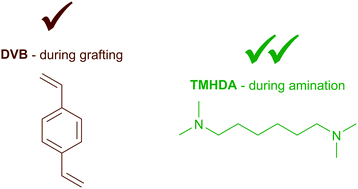Radiation-grafted anion-exchange membranes for reverse electrodialysis: a comparison of N,N,N′,N′-tetramethylhexane-1,6-diamine crosslinking (amination stage) and divinylbenzene crosslinking (grafting stage)†
Abstract
Radiation-grafted anion-exchange membranes (RG-AEM) are being developed to evaluate a range of chemistries that have relevance to a variety of electrochemical applications including reverse electrodialysis (RED) salinity gradient power. RG-AEMs are typically fabricated using an electron-beam activated (peroxidated) polymer substrate film. These activated films are first grafted with a monomer, such as vinylbenzyl chloride (VBC) and then reacted with a variety of tertiary amines to yield the desired RG-AEMs. The amination process forms covalently bound quaternary ammonium (QA) head-groups that allow the RG-AEMs to conduct anions such as Cl−. RG-AEMs are of interest as they exhibit high conductivities (100 mS cm−1 at elevated temperatures when containing Cl− anions). However, the current generation of RG-AEMs have two main Achilles' heels: (1) they exhibit low permselectivities; and (2) they exhibit a high degree of swelling in water. Introducing covalent crosslinking into ion-exchange membranes is a well-known strategy to overcome these issues but it often comes with a price – a significantly lowered conductivity (raised in situ resistance). Therefore, the level of crosslinking must be carefully optimised. RG-AEMs can be primarily crosslinked using two methods: (1) introduction of a divinyl monomer into the monomer mixture used during grafting; or (2) introduction of a diamine agent into the amination process. This study looks into both methods where either divinylbenzene (DVB) is added into the grafting mixture or N,N,N′,N′-tetramethylhexane-1,6-diamine (TMHDA) is added into the amination mixture. We show that on the balance of two application-relevant properties (resistances in aqueous NaCl (0.5 mol dm−3) solution and permselectivity), the diamine crosslinking method is the most effective for RG-AEMs being used in RED cells.



 Please wait while we load your content...
Please wait while we load your content...